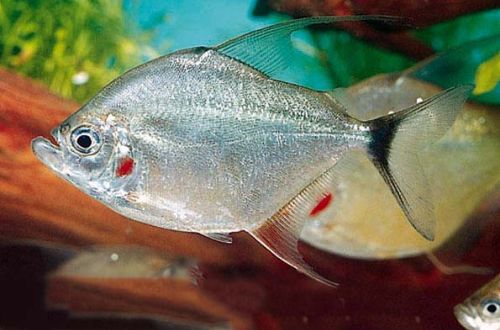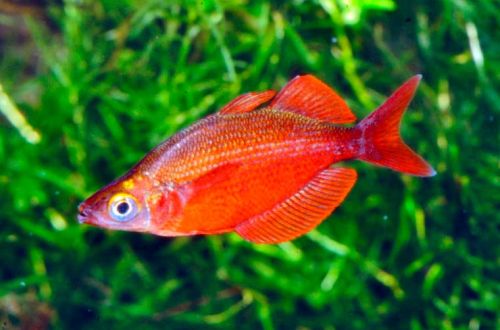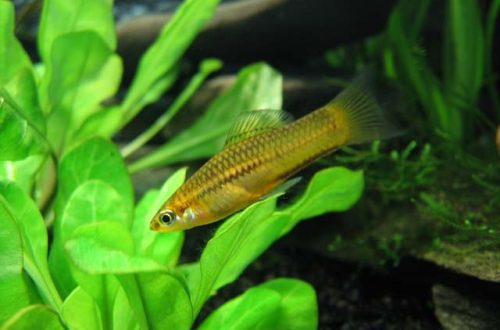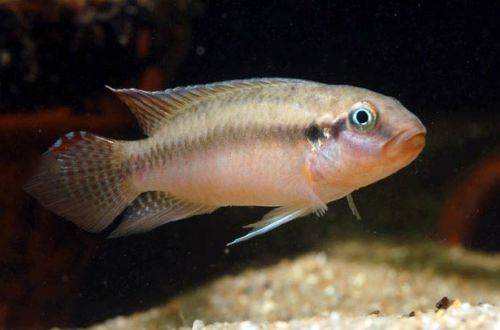
Congochromis sabina
Sabina’s Congochromis, scientific name Congochromis sabinae, belongs to the Cichlidae family. The fish appeared in the aquarium trade in the 1960s, long before it had a scientific description. At the time, it was called the Red Mary fish (an allusion to the color of the cocktail of the same name) and this name is still often used in relation to this type of cichlid.
It is easy to keep and breed if it is in the right conditions. Compatible well with many other species. May be recommended for beginner aquarists.

Cuprins
Habitat
It comes from the equatorial region of Africa from the territory of Gabon, the Congo and the northern territories of the Democratic Republic of the Congo. Inhabits the basin of the Congo River of the same name, one of the largest on the continent. Prefers small streams and rivers flowing under the canopy of moist rainforests. The water in these rivers is colored brown due to the abundance of tannins released as a result of the decomposition of plant organic matter – branches, tree trunks, fallen leaves, fruits, etc.
Informatie scurta:
- Volumul acvariului – de la 50 de litri.
- Temperatura – 24-27°C
- Valoare pH — 4.0–6.0
- Water hardness – low (0-3 dGH)
- Tipul de substrat – nisipos
- Iluminare – slabă
- Apa salmastra – nr
- Mișcarea apei este slabă
- Dimensiunea peștelui este de 4-7 cm.
- Nutriție – alimente pe bază de plante
- Temperament – pașnic
- Păstrarea în pereche sau în harem cu un mascul și mai multe femele
Descriere
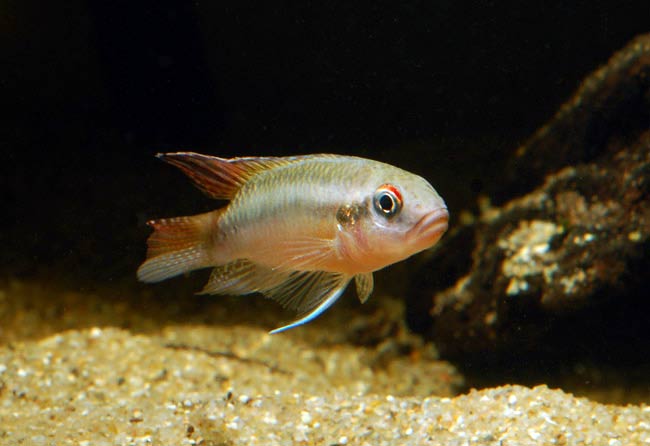
Males reach 6–7 cm, females are somewhat smaller – 4–5 cm. This is where the visible differences between the sexes end. The coloration of the upper part of the body is gray, the lower part is with pink or red hues. The fins and tail are translucent, the upper lobes have a red-blue edging and a few specks of the same colors. During the spawning period, the color becomes predominantly red.
Alimente
It feeds near the bottom, so the food should be sinking. The basis of the diet are products based on herbal ingredients, such as spirulina algae. You can diversify the diet with frozen daphnia, brine shrimp, pieces of bloodworms, which are served 2-3 times a week, that is, they serve only as an addition to the main plant food.
Întreținere și îngrijire, amenajarea acvariului
The optimal size of the aquarium for a pair of fish starts from 50 liters. For a group of 3-5 fish and when kept together with other species, a much larger tank will be required (from 200 liters or more). It is desirable that the design resembles a natural habitat. It is necessary to provide places for shelters in the form of small caves or closed shady areas formed by snags and dense thickets of plants. Some aquarists add small ceramic pots tipped on their side, or hollow pieces of pipes, from 4 cm in diameter. These will serve as a potential spawning site. The lighting is subdued, so living plants should be chosen among shade-loving species. Dried leaves of some trees located at the bottom also serve as an inapplicable design attribute. Read more in the article “Which tree leaves can be used in an aquarium.” Leaves are not only part of the interior decoration, but also have a direct impact on the composition of the water. As in natural water bodies, as they decompose, they release tannins that turn the water into a characteristic brown color.
Having equipped the aquarium, in the future it is required to service it. If there is a productive filtration system and if the fish are not overfed, then the care procedures are as follows: weekly replacement of part of the water (15–20% of the volume) with fresh water, regular removal of organic waste by siphon (remains of food, excrement, old leaves, etc. .), preventive maintenance of equipment according to manufacturer’s instructions, control of key water parameters (pH and dGH), as well as concentrations of nitrogen cycle products (ammonia, nitrites, nitrates).
Comportament și compatibilitate
Males are territorial and compete with each other for bottom space. In a small aquarium, there should be only one adult male in the company of a female or a group of females. Compatible with other peaceful schooling species from among the characins, cyprinids, as well as with South American cichlids, corydoras catfish and others.
Creștere / reproducere
Easy to breed, in favorable conditions, spawning occurs regularly. It is worth noting that although Congochromis Sabina can live with relatively little hardness, the eggs will only develop in very soft acidic water. You may need to use a reverse osmosis filter.
The fish are not demanding on partners, so it is enough to settle one male and a female together to get offspring. Courtship is initiated by the female, after a short “marriage dance” the couple finds a suitable place for themselves – a cave, where spawning takes place. The female remains inside near the masonry, and the male guards the territory around her. The duration of the incubation period depends on the temperature, but usually takes about 3 days. After 8–9 days, the fry that have appeared begin to swim freely. The parent continues to protect their offspring for another two months before leaving the fry to themselves.
Bolile peștilor
Cauza principală a bolilor constă în condițiile de detenție, dacă acestea depășesc limitele permise, atunci apare inevitabil suprimarea imunității, iar peștele devine susceptibil la diferite infecții care sunt inevitabil prezente în mediu. Dacă apar primele suspiciuni că peștele este bolnav, primul pas este verificarea parametrilor apei și prezența unor concentrații periculoase de produse din ciclul azotului. Restabilirea condițiilor normale/adecvate promovează adesea vindecarea. Cu toate acestea, în unele cazuri, tratamentul medical este indispensabil. Citiți mai multe despre simptome și tratamente în secțiunea Boli ale peștilor de acvariu.



